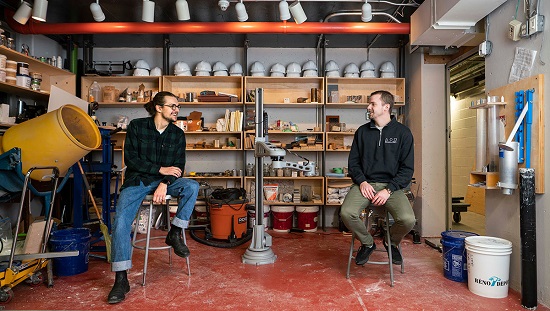 Tuesday, October 1, 2024
Tuesday, October 1, 2024  Tuesday, October 1, 2024
Tuesday, October 1, 2024 
Recycled hemp biomass, water and lime. Cement, sand, fibres, plasticizers and water.
Combine the first group of ingredients in the correct ratio and you can make hemp building blocks that perform exceptionally well as insulation and, with the right compression, could also work as a structural material in walls. Mix the second set and tweak the formula properly and you can use a 3D printer to produce thin slabs of ultra-high-performance concrete.
Both are building materials with the potential to reduce our carbon footprint — and both are being developed by master’s students in the Carleton Sensory Architecture and Liminal Technologies (CSALT) laboratory in the basement of the university’s Architecture Building.
While the majority of Carleton students have spent the last 10 months learning from home on their laptops, Robin Papp (who literally has his hands in the hemp) and Sinan Husic (who is experimenting with concrete) couldn’t complete their master’s research without getting into the lab a couple days each week.
Architecture is an academic discipline that requires interplay with the physical world. Thankfully, Carleton’s Azrieli School of Architecture and Urbanism has the space — and the will — to find ways for students to safely continue in-person work that addresses global challenges such as climate change.
“Hands-on learning provides an entirely different way of knowing something, which is vital for architecture,” says Prof. Sheryl Boyle, who supervises Papp and Husic and secured the MITACS grants that fund their research partnerships with Hurd Solutions and the Canadian Precast/Prestressed Concrete Institute.
“Architectural imagination mediates our ideas or concepts and sensory experience,” continues Boyle.
“Both of these projects address the material makeup of our buildings,” she adds, “and the material makeup of our buildings needs to change.”